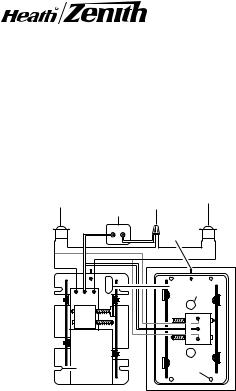Heath Zenith 122C, 121AC, 125C User Manual

P.O. Box 90004
Bowling Green, KY 42102-9004
Hardwired Mechanical Chimes
Illustrations may vary from actual chime unit.
MOUNTING SUGGESTIONS
•Power must be supplied from a 16 Volt, 10 Watt transformer or 16 Volt, 15 Watt transformer (Heath®/Zenith models 122C, 121AC, or 125C).
•Mount door chime in a central location so it can be heard throughout the home.
•See actual unit for orientation of base.
•Use wall anchors if not mounting directly to wall stud.
•Use mounting holes located on both sides of base.
•Route wires through wire entrance holes (see Figure 1).
NEW INSTALLATION WIRING WARNING:Turn power off at fuse or circuit breaker before installing transformer. Follow all national and local codes.
1.MountTransformer: Transformers should be mounted on or near a junction box. They can also be mounted to the electrical service panels. Junction boxes in utility rooms, crawl spaces, or basements are preferred. Avoid attic locations.
2.Install 16 Volt, 10 Watt transformer according to the instructions supplied with transformer. Note: For multiple mechanical chimes, use a 16 Volt, 15 Watt transformer. Failure to use a transformer with adequate power will result in loss of sound or may result in the system being inoperative.
3.Run two No. 20 AWG or better bell wires (Heath®/Zenith No. 196C or No. 199C accessory wire) to the chime location. Strip away 1/2" of insulation from end of wires. Connect each wire to transformer (see Figure 1).
Rear Push Button |
|
Front Push Button |
|||
(If Applicable) |
|
Wire Nut |
|||
|
|
|
|||
|
|
Transformer |
|
|
|
|
|
|
Cover Pin |
|
|
|
|
|
|
Wire Entrance |
|
REAR |
TRANS |
FRONT |
|
Holes |
|
|
|
|
|||
|
|
|
|
DO NOT OIL |
FRONT REAR TRANS |
|
Mounting |
|
Mounting |
||
|
|
Hole |
|
||
|
Slot |
|
|
|
|
|
|
|
|
|
|
|
|
|
Optional Second Mechanical Chime |
||
Base Style “A” |
|
Base Style “B” |
|||
Figure 1
4.Label Transformer Wires: Using masking tape or wire tags provided on packaging, label one wire “T” and the other “C”.
© 2003 DESA Specialty Products™ |
598-1112-01 |
5.Mount push button(s) to door frame(s). Run two No. 20 AWG bell wires from push button(s) to the chime location. Strip away 1/2" of insulation from end of wires. Connect each wire to push button(s) (see Figure 1).
Label Front Push Button Wires: Using masking tape or wire tags provided on packaging, label one wire “F” and the other “C”.
Label Rear Push Button Wires: Using masking tape or wire tags provided on packaging, label one wire “R” and the other “C”.
6.At the chime, pull all wires through wall cavity and out through a 1/2" hole in the wall board. Route wires through wire entrance hole(s).
7.Mount chime base to wall using screws provided.
8.Strip away 1/2" of insulation from end of wires. Connect wire “F” to the screw terminal marked “FRONT”. Connect wire “T” to screw terminal marked “TRANS”. Connect wire “R” to screw terminal marked “REAR” (see Figure 1).
9.Twist together the wires labeled “C” and secure them with a UL approved wire nut.
10.Place chime cover securely over base.
11.Restore power. Press push button(s) to test chime.
REPLACEMENT INSTALLATION WIRING
For replacing an existing transformer, follow step 2 above.
WARNING: Turn power off at fuse or circuit breaker before installing transformer.
1.Verify existing chime/bell system works correctly. If no sound is heard, see Troubleshooting section for more information.
2.Check transformer power rating. This chime requires a minimum 16 Volt, 10 Watt transformer.
3.Remove cover from existing chime and disconnect wires from terminal screws. Using masking tape or wire tags provided on packaging, label all wires (“F”-Front Push Button, “T”-Transformer, “R”-Rear Push Button) as you remove them according to terminal markings.
4.Remove existing chime base from wall.
5.Route wires through wire entrance hole(s) in new chime base.
6.Mount chime base to wall using screws provided.
7.Connect wire “F” to the screw terminal marked “FRONT”. Connect wire “T” to screw terminal marked “TRANS”. Connect wire “R” to screw terminal marked “REAR” (see Figure 1). Note: The common connection may exist elsewhere in the original installation and may not be visible.
8.Place chime cover securely over base.
9.Restore power. Press push button(s) to test chime.
Note: For multiple mechanical chimes, use a 16 Volt, 15 Watt transformer.
HELPFUL HINTS
•Electrical work must be in accordance with national and local electrical codes. If in doubt, consult a qualified electrician. Turn power off at fuse or circuit breaker before installing/ replacing transformer.
•Many chimes, bells, and buzzers are installed with a 10 Volt, 5 Watt transformer. This chime requires a minimum 16 Volt, 10 Watt transformer.
•For replacement installation, identify and tag wires before removing them according to terminal markings: “F”-Front Push Button, “R”-Rear Push Button, and “T”-Transformer.
•For new installations install #20 AWG bell wire in pairs from push button(s) and transformer to chime. Do not pinch wire or damage its insulation. Heath®/Zenith accessory wire (No. 196C or No. 199C) is available for chime installations.
•Clean wood, plastic, and metal parts with mild soap and warm water. Never use cleaners or polishes. Never use any fluids on the mechanical chime mechanism.
-2- |
598-1112-01 |

TROUBLESHOOTING
Chime does not sound:
•Check Chime: Disconnect wire from terminal marked “TRANS”. Have someone operate push button at front door while you momentarily touch the “TRANS” wire to terminal marked “FRONT”. You will see a small spark if push button, wiring, and transformer are operating properly. Repeat the steps for “REAR” terminal and rear push button. If wiring between transformer and push button(s) check out properly, replace chime.
•Check Transformer: Momentarily touch the two low-voltage terminals with a screwdriver. You will see a small spark if transformer is operating properly. If no spark is evident, replace transformer.
•Check Push Button(s): Remove suspected unit from door frame, disconnect wire from terminals and touch bare wires together. If chime operates, push button is defective. Replace push button.
TECHNICAL SERVICE
(Do Not Send Products)
If you experience a problem, follow this guide. You may also want to visit our Web site at: www.desatech.com. If the problem persists, call* for assistance at 1-800-858-8501, 7:30 AM to 4:30 PM CST (M-F). You may also write* to:
DESA Specialty Products™
P.O. Box 90004, Bowling Green, KY 42102-9004 ATTN: Technical Service Specialty Products
* If contacting Technical Service, please have the following information available: Model Number, Date of Purchase, and Place of Purchase.
No Service Parts Available for this Product
ONE YEAR LIMITED WARRANTY
This is a “Limited Warranty” which gives you specific legal rights. You may also have other rights which vary from state to state or province to province.
For a period of one year from the date of purchase, any malfunction caused by factory defective parts or workmanship will be corrected at no charge to you. To obtain a refund or a replacement, return the product to the place of purchase. Not Covered - Repair service, adjustment and calibration due to misuse, abuse or negligence, and expendable items are not covered by this warranty. Unauthorized service or modification of the product or of any furnished component will void this warranty in its entirety. This warranty does not include reimbursement for inconvenience, installation, setup time, loss of use, or unauthorized service.
This warranty covers only DESA Specialty Products™ assembled products and is not extended to other equipment and components that a customer uses in conjunction with our products.
THIS WARRANTY IS EXPRESSLY IN LIEU OF ALL OTHER WARRANTIES, EXPRESS OR IMPLIED, INCLUDING ANY WARRANTY, REPRESENTATION OR CONDITION OF MERCHANT ABILITY OR THAT THE PRODUCTS ARE FIT FOR ANY PARTICULAR PURPOSE OR USE, AND SPECIFICALLY IN LIEU OF ALL SPECIAL, INDIRECT, INCIDENTAL, OR CONSEQUENTIAL DAMAGES.
REPAIR OR REPLACEMENT SHALL BE THE SOLE REMEDY OF THE CUSTOMER AND THERE SHALL BE NO LIABILITY ON THE PART OF DESA SPECIALTY PRODUCTS™ FOR ANY SPECIAL, INDIRECT, INCIDENTAL, OR CONSEQUENTIAL DAMAGES, INCLUDING BUT NOT LIMITED TO ANY LOSS OF BUSINESS OR PROFITS, WHETHER OR NOT FORESEEABLE. Some states or provinces do not allow the exclusion or limitation of incidental or consequential damages, so the above limitation or exclusion may not apply to you. Retain receipt for warranty claims.
DESA Specialty Products™ reserves the right to discontinue and to change specifications at any time without notice without incurring any obligation to incorporate new features in previously sold products.
598-1112-01 |
-3- |

P.O. Box 90004
Bowling Green, KY 42102-9004
Campana mecánica con cableado blindado
Las ilustraciones pueden variar de la unidad de campana real.
SUGERENCIAS DE MONTAJE
•La energía debe suministrarse desde un transformador de 16 Voltios, 10 Vatios o desde un transformador de 16 Voltios, 15 Vatios (Modelos 122C, 121AC, ó 125C Heath®/Zenith).
•Montar la campana de la puerta en una ubicación central de manera que pueda escucharse en toda la casa.
•Ver la unidad real para la orientación de la base.
•Usar anclas de pared si no se monta directamente a un montante de pared.
•Usar orificios de montaje ubicados a ambos lados de la base.
•Encaminar los cables a través de los orificios de entrada del cable (ver la Figura 1).
CABLEADO PARA UNA NUEVA INSTALACION
ADVERTENCIA: Desconectar la |
Pulsador posterior |
Pulsador delantero |
||||
energía al fusible o al interruptor de |
(Si es aplicable) |
|||||
circuito antes de instalar el |
|
|
|
Tuerca de cable |
|
|
|
|
Transformador |
|
|
||
transformador. Observar todos los |
|
|
|
Clavija de |
|
|
códigos nacionales y locales. |
|
|
|
|
|
|
1. Montar el transformador: Los |
|
|
|
la cubierta |
|
|
|
|
|
|
|
|
|
transformadores deben montarse en |
|
|
|
|
|
|
o cerca de una caja de empalmes. |
|
|
|
|
|
|
Pueden montarse también en los |
|
|
|
|
|
|
paneles de servicio eléctrico. Se |
|
|
|
Orificios de |
|
|
prefieren las cajas de empalme en |
|
|
|
|
||
|
|
|
entrada del |
|
||
cuartos de herramientas,sótanos muy |
REAR |
TRANS |
FRONT |
|
||
cable |
|
|
||||
bajos, o sótanos. Evitar los altillos. |
|
|
|
|
|
|
2. Instalar el transformador de 16 voltios, |
|
|
|
DO NOT OIL |
FRONT REAR |
|
10 vatios de acuerdo con las |
|
|
|
TRANS |
||
instrucciones provistas con el |
|
|
|
|||
transformador. Nota: Para campanas |
|
|
|
|||
|
|
|
|
|
|
|
mecánicas múltiples, usar un |
|
|
|
Orificio de |
|
|
transformador de 16 voltios, 15 vatios. |
|
Ranura de |
|
|||
El no usar un transformador de una |
|
montaje |
|
|
||
|
montaje |
|
|
|||
|
|
|
|
|||
potencia adecuada resulta en la pérdida de sonido o puede resultar
en un sistema inoperante. |
Segunda campana mecánica opcional |
|
3. Tender dos cables de timbre No.
20 AWG o mayor (cables accesorios No. 196 ó No. 199C
Heath®/Zenith) a la ubicación de la campana. Pelar 1/2 de pulgada de aislamiento de extremo a extremo de los cables. Conectar cada cable al transformador (ver la Figura 1).
4.Rotular los cables del transformador: Usando cinta adhesiva o los rótulos de cable provistos en el empaque, rotular un cable "T" y el otro "C".
© 2003 DESA Specialty Products™ |
-4- |
598598-1112- 112-01-01S |
